73 Commodes Around the World
Commodes of the World
By Rick Bein
The seating position for defecation is unnatural and must be learned early, by three years of age, for it to be comfortable. The natural position for defecation is squatting; the position used by early humans and still in most parts of the world.

Modern loo in the USA. Photo by Rick Bein 2020.
I remember toilet training as a child, sitting for hours trying to train my muscles to do the elimination while seated. My mother would place me on the “loo” every day until I performed. It was a boring difficult process that I dreaded and avoided. The process actually created constipation, since I frequently did not completely eliminate, but would squeeze out a small nugget to get my mother’s approval and then I could go about enjoying the rest of the day. My preference was to wait three days until I could produce something for which I could be proud. Sadly, my family did not appreciate my creativity because they frequently had to call a plumber. (Heaven forbid, that all my creativity was going down the drain). However, my mother was somewhat relieved relived that I had not flushed. When I did flush, the plumber, however appreciated me.
Learning to squat
It never occurred to me that there was any other way to defecate. It was not until I went into the Peace Corps that I was faced with a pit latrine where I was supposed to release into the six inch diameter hole in the floor. Once I got the aim down, I found that this was a viable option.

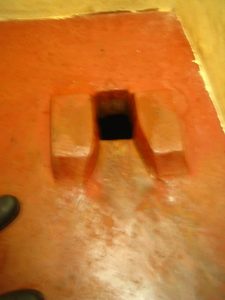
My squat toilet in Mato Grosso Brazil. Photo by Rick Bein 1971.
Improved squat toilet in Indonesia. Photo by Rick Bein 1998
The only difficulty with this option was that I had never learned to squat with my feet flat on the floor so I teetered back and forth on my toes trying to keep my balance. If I were to fall, I dreaded on what I might be landing. I noticed that many 3rd world people had learned to squat idly for hours with their feet flat on the ground. How did they learn that? For them toilet training included squatting with your feet flat on the floor. If you do not train your ankles to squat when you are a child it will be difficult to do it when you are an adult.
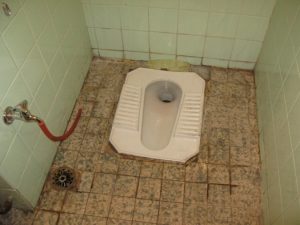
Flush toilet with washing hose in Syria with squatting pan by “Sustainable Sanitation” is licensed free under CC BY 2.0.
On the other hand, those people who were accustomed to defecating in the squatting position had a very difficult time trying to sit and defecate. I discovered their solution when I found foot prints on the toilet seat! Even then, the Western influence went far and wide, and many of the 3rd world people struggled to learn to sit and “shit” at the same time. At one bus stop in western Brazil a “sit down” toilet had been installed in a bathroom, but with no plumbing. Everyone had been perching on the toilet bowl adding their deposit to the top of the heap. Excrement stood two feet above the rim and whoever was in charge had long since fled the scene. I decided it was too dangerous to try to contribute to that and found a slightly cleaner spot in the corner of the room to relieve myself.
Sanitation frequently becomes a problem like these series of hole in the floor toilets at the back of these houses. Here the waste falls into a drainage ditch that flows off to the local river.
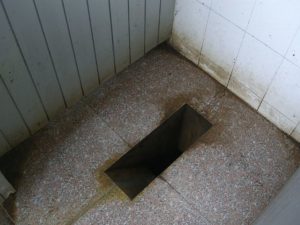
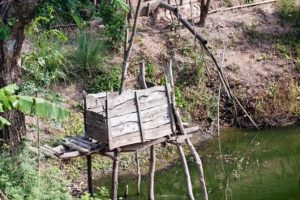

Basic sanitation –Jiey Indian Temple by avlxyz is licensed free under CC BY-SA 2.0
Toilet” by anthonli is licensed free under CC BY-NC-SA 2.0. Household solutions pollute neighborhood water supplies.
Series of backyard toilets over a Mexican community ditch draining into local waterway. Photo by Rick Bein 1984.
Another scenario I witnessed was the multiple use of a stream flowing through a squatter community where women were collecting water for their household needs. Upstream another group of women were washing clothes and further up was a man urinating close to the stream.
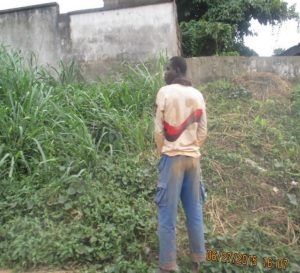 Man urinating close to the stream. Photo by Rick Bein 2015. Public toilet by Matthew L Stevens, licensed free under CC BY-NC-ND 2.0
Man urinating close to the stream. Photo by Rick Bein 2015. Public toilet by Matthew L Stevens, licensed free under CC BY-NC-ND 2.0
I have since noticed that many public bathrooms around the world do have fancy porcelain squat toilets that flush and are clean and maintained.


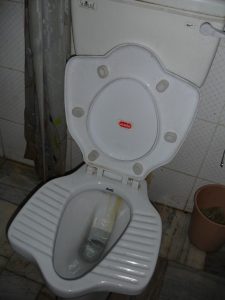
In a country where squat toilets are still prevalent, this sign is necessary. by Nicole Lee is licensed free under CC BY-NC-SA 2.0
Hybrid_squat_toilet_(207097770) FileHybrid squat toilet (207097770).jpg by Chris Conway,
Hilleary Osheroff is licensed free under CC BY-SA 2.0 One can pull the lid down to sit.
Alex, my son, an Officer in the U.S. Navy, related a story of Iraqi sailors he was training onboard his ship in 2006. It was normal for the Iraqis to squat, but there were no squat toilets available on the U.S. Ship. In heavy seas it was far too dangerous for them to try to squat with their feet on the seat. Within a few days they began squatting over the shower drains to eject their waste. It did not take long for those drains to become clogged, causing flooding in the restroom. With their refusal to sit on the toilet, the bathrooms were outfitted with a pan into which they could easily defecate and then pour the contents into the toilet, preventing further messes.
Using the left hand
The Middle Eastern approach to the bathroom has a different twist. Here, the use of toilet paper is not common. Instead, a small ewer of water is carried into the restroom and the left hand is used to wash after finishing. Often a small hose with a tap is available to administer the water. In homes of means, a small water pipe is installed inside the back of the sit-down toilet controlled by a tap located conveniently below on the back side. The metal pipe is strategically aimed at a specific part of the anatomy.
Usually there is no way to dry off as it is expected that the hot dry climate will take care of that. I remember as a part of toilet training my father insisted that I use the left hand with toilet paper to wipe with. I don’t know how he had any sense of this Arab tradition.
In Sudan in the 1970s, when I taught at the University of Khartoum, I observed that the few locked bathrooms were much protected, and, for the masses of lower-class people there were no public restrooms. Fortunately, most of the people dressed in their own bathrooms. The men wore a “jalabia”, a long white gown that extended from the shoulders to the ankles. The women wore a “thobe”, a similar garment that reached below the ankles. With these ready-made portable outhouses people squatted in any open area to take care of themselves. Empty lots served as public restrooms and were dotted with sun-dried fecal deposits. And the “bottom line” was that their left hands were all they had to clean themselves. The ornate city parks left by the British colonials seemed to have acquired a different purpose.
The use of the left hand in the Middle East has become delegated for this use only. Even though the hand is washed with soap and water, this means everything else in one’s life must be done with the right hand. If one is left-handed, the right hand must be trained to do all those other things. I think this started in times past with the nomadic herders, whose little water in the desert, was used for drinking, not for washing. As a result, that left hand remained dirty. The hands were kept segregated in order to maintain some semblance of sanitation. I am told that the Koran defines the distinction between the left and right hands. Consequently, left-handed people became ostracized unless they faked it.
Writing, for an example, had to be done with the right hand. The few lefties were “SOL” because writing with their right was very awkward and often illegible. Nevertheless, their handwriting was never as neat as that of regular right-handers. When I taught in the Sudan in the 1970s, all school assignments and exams were done by writing and legible handwriting was required to pass. As a result many left handed students could not master good handwriting with their right hand and were not promoted to the next level of schooling. When proctoring group exams at the University of Khartoum, I was able to distinguish only one person out of a thousand writing with his left hand and that person was from southern Sudan.
One of the most severe penalties for thieving in the Arab world is to chop off the right hand. That forces the person to be the lowest of the low because he will now have eat with his left hand and no one will have anything to do with him.
When I first arrived in Khartoum, I was advised of this “left hand business” and regardless of how clean my left hand was or how much I washed it, I learned to never touch any one with it and to never eat with it. In the processes of embodying this, I did forget one time. One week after arriving in the Khartoum, Sudan in 1974, I had the opportunity to travel to the northern city of Dongola upstream from where the Nile runs into Lake Nubia (Lake Nasser in Egypt) on the Egyptian border, and I jumped at the opportunity!
The means of travel was an awning covered truck with seats bolted to the truck bed. My colleague and I were given some privilege because we were white, and were allowed to travel in the cab with the driver. It was also Ramadan, the month when Muslims fast during the daylight periods. Although Muslim travelers are supposed to be exempt from this requirement, the devout Sudanese on this trip still abided by the practice.
Normally, trans-desert journeys are done in the cool of the night so that a convoy of trucks can follow one another spaced a quarter of a mile apart by watching the red taillights ahead. That way the travelers avoided the dust stirred up by that truck. Traveling at night also meant that no one would ever get lost because the brilliant stars above provided perfect orientation. There was no specific road as the shifting desert sands covered everything up. Direction was provided by the stars. Prior to GPS one could get lost traveling during the day.
We left Khartoum at 4 PM just as the 100 F degree heat of the day was diminishing and drove until sundown. At sundown we stopped along the road and a huge blanket was stretched out on the sand and tons of food appeared from all the travelers. Everyone sat down around the “Ramadan Breakfast” and began eating. My colleague and I were invited to join and we did not hesitate. There were some delicious foods set before us and everyone was enjoying themselves until I made one devastating error. I picked up a drumstick with my left hand!
Suddenly I had the entire feast to myself, as everyone got up and walked away in disgust. I was mortified when I realized what I had done and apologized, but it did not bring the people back. That was one major learning event for me!
I discovered how they taught their naturally left-handed children not to eat with their left hand. This happened when I took my four year old twin daughters with me to a village in the Gizira Scheme. Crowded around a feast, we began to eat with everyone else. One of my daughters was left-handed, and to prevent her from eating with her left hand, one of the adults reached behind his back with his left hand and grasped her left hand, preventing her from using it. She was not very happy with that, but she was hungry and it forced her eat with her right hand.
New Guinea Coastal people
Toilets for the Kamiali people of coastal Papua New Guinea were not-existent. Their early morning rituals were to wade, waste deep out just beyond the breaking waves of the Pacific and release what was necessary into the water. At first it was not obvious what they were doing, but when I needed the restroom, there was none. After some thought, I figured it out. This created a new dimension to the expression “I am going out to feed the fish!
As I tried this new adventure, I discovered that there was more complexity to this feat that I had expected. As it turns out there was a symbiotic relationship with the local fish who feasted on the deposits left in the water. To fill the ecological niche, the fish often became impatient if someone took too long to complete the task and would begin banging into the person’s rear-end, encouraging him to hurry. This was a bit unnerving!

Aquatic relation between fecal deposits and local fish. Photo by Rick Bein 1998.
Furthermore, if the person positioned oneself in the right way, the fish would even clean off the residue. In other words, toilet paper was not necessary. There was one ecological dimension with this relationship. There were no trees chopped down to make paper! A second involved recycling, as the villagers caught and ate those same fish!
In the inland villages in Papua New Guinea, I had noticed clustering of young papaya plants growing along roads in places where they would not normally be planted. There was no order to where these plants were growing, just clumped together in a random pattern. Also, these clusters were located on the outskirts of populated places near wooded areas on the periphery of household compounds and at somewhat secluded sites along roads.


Papaya growing from seeds that survive the human digestive tract. Photo by Rick Bein 1998.
“Large Copper Dung-Beetle (Kheper nigroaeneus)” by berniedup 2010 is licensed free under CC BY-SA 2.0
I wondered why these papaya plant clusters were located in this way. It finally dawned on me that these were defecation spots that were convenient but somewhat separate from the mainstream of human traffic. To go along with that I realized that papaya seeds survive the processing of the human digestive tract. In the rainy tropics, delicious papaya fruits are readily available at low cost in markets and easily pilfered from these garden plants. As a source of health and energy, these fruits are quite satisfying and are commonly eaten by everyone. But when people found themselves in an urgent condition away from any bathroom facilities, a somewhat secluded site along the edge of a wooded area served their need.
Papaya seeds germinate quite readily in this highly enriched organic soil, growing quickly to provide an even more private place for future people needing to relieve themselves. Over a period of time, more and more inadvertent papaya plants begin to emerge, and a rather private reprieve evolves and expands. Of course, fruits falling from these plants easily contribute more seeds to this small cluster. The accompanying picture offers you a more vivid example.
Dung Beetles
Among the Yanguara people of South Sudan, where I visited one of my students, I discovered that they had no toilets. Here, when the urge came, one merely walked away from the group to the closest thicket or grove of trees and did this business.
When I tried this while staying at the farmstead, I began returning to the same place where I had made that last deposit and was surprised to find that there was no evidence that I had ever been there. Something must have been removing that evidence! Remembering Peter Froiken’s Book of the Eskimos, it was the sled dogs that feasted on the remains. I came to an early conclusion that it must be the local hyenas that I imagined were lurking around the periphery of the farmstead!
I found out the truth when I made an earlier than usual visit to the area. There I saw marble size balls of my excrement slowly rolling along on the ground. Upon further examination, I noticed it was dung beetles who were taking it to their burrows to feed their nestlings.
Bring this back to the USA.
The homeless people have a problem as to where they are to defecate. In San Francisco where the climate is very mild, not too hot, not too cold, thousands of homeless live in the streets. Usually in the dead of night some of the more thoughtful will do their business over a storm drain, leaving very little evidence. But frequently, there is no such convenience, and the sidewalk becomes the dumping ground. In some situations excremental art has shocked a few daytime walkers on their way to work. One must be very careful about where to walk! Stray dogs try to help, but the city has not taken this seriously. Recently they put up a few porta-potties in the worst areas of town, but this has done little to ameliorate the problem.

While there are fewer homeless people than there have been in the past, the gentrification of San Francisco has had a severe effect on the homeless. Photography by David Leven for the Guardian News paper.
“It’s an empirical fact: San Francisco is a crappier place to live these days. Sightings of human feces on the sidewalks are now a regular occurrence; over the past 10 years, complaints about human waste have increased 400%. People now call the city 65 times a day to report poop, and there have been 14,597 calls in 2018 alone. Last year, software engineer Jenn Wong even created a poop map of San Francisco, showing the concentration of incidents across the city. New mayor London Breed said: “There is more feces on the sidewalks than I’ve ever seen growing up here.” In a revolting recent incident, a 20lb bag of fecal waste showed up on a street in the city’s Tenderloin district.” Guardian News Paper.

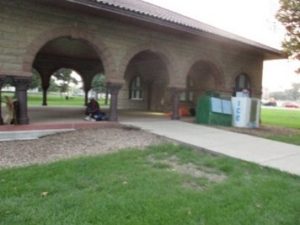

Homeless in Washinton DC.
Gazebo harboring homeless people in Indianapolis.
Porta-potties, strategically located, could solve some problems. Photos by Rick Bein 2019.
When my stepdaughter, who works in downtown Indianapolis drops me off at the government parking garage, I cross Military Park as I walk to campus. In the early morning hour of 7:30 several homeless are still sleeping in the gazebo there. I often wonder how they handle their bathroom needs. I have been extra observant where I step when walking through the area. I contacted the city sanitation department about setting up a porta-potty for them, but so far nothing has happened. Who wants to listen to this loony professor?
Not to demean the big picture of American toilets, science has mastered the art of toiletry with the invention of the motion sensing toilet stool that flushes when one least expects it. With this sophisticated invention the person never gets to inspect what has just been produced.
One concern I have for the Western custom of using toilet paper is the toll it takes on the forests. The use of water for cleaning (like with a bidet) is much more environmentally friendly. With the onset pandemic of covid 19 in 2020, and the prospect of household shortages, the run-on toilet paper illustrates the dependence of this destructive habit. However, we should feel hopeful that the wood-pulp industries are maintaining significant reforestation efforts.

